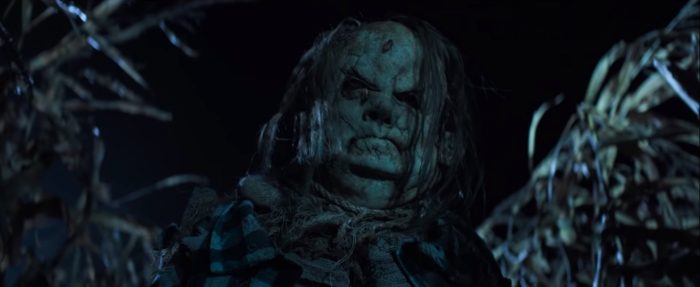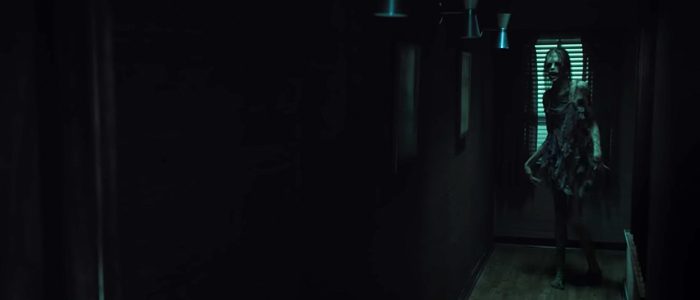‘Scary Stories to Tell in the Dark’ Director André Øvredal on Building the Movie’s Biggest Scares [Interview]

Studio horror movies made for teenagers rarely get much better than Scary Stories to Tell in the Dark. Based on the books written by Alvin Schwartz and illustrated by Stephen Gammell, the horror movie has a more classical than modern approach to its scares. André Øvredal‘s movie relies almost entirely on tension, not jump scares, although it delivers on those, too.
Executive produced by Guillermo del Toro, Øvredal’s movie has a similar handmade quality to its mostly practical monsters: The Pale Lady, the Jangly Man, the Toe Monster, and Harold the Scarecrow. The four of them are as nightmare-inducing as the unshakeable illustrations of the original books. As Hoai-Tran Bui wrote in her review, “Scary Stories to Tell in the Dark effectively captures the primal horror of campfire stories while doing justice by Schwartz’s creepy designs in a marriage of old-fashioned practical thrills and sleek modern effects.”
Øvredal took some time to tell us about those thrills and modern effects during a recent phone interview, but if you’ve yet to see the movie, you may want to wait to read what he had to say about movie’s scariest scenes. Some minor spoilers lie ahead.
I really enjoyed this, and while it is scary to me, I walked out thinking it would’ve scared the hell out of me as a kid.
That’s wonderful [Laughs]. I totally get that, and in a way, it’s the dream scenario that people of that age will grow up liking this movie and having a memory of it. Also, obviously, that an adult can appreciate it, too. No, that’s great to hear.
I want to ask you about the movie’s biggest scares, starting with Auggie hiding under the bed and looking around the room for the Toe Monster. It’s so well-timed. For you, what was the perfect length to keep people on their toes?
We tried a couple of different variations on that scene. We had more shots of the creature, and we could’ve extended the scene, but there’s something about being sharp and going forward and forward relentlessly. I mean, I love building anticipation and suspense, because it’s all about the camera, actors, sound, and tension. I love playing with that stuff; it’s pure cinema, where I’m most comfortable.
How about the cornfield chase with the bully and Harold? What work did it take to make Harold move in a believable way?
I wanted it to move very stiffly like it really was made of wood, not a person in a suit. The tricky part was trying to make it a chase when he’s so stiff in his movements, and trying to give him the power and the oomph to attack. We had a really great actor (Mark Steger) able to do all these movements and portray this menacing wooden force that I was hoping for. That was probably the most intense couple of shooting days on the whole movie because we had to make a huge, elaborate walk path in this enormous cornfield. We had to create this almost military operation, shooting down a corridor for that shot, then shooting down that corridor for those shots. It was probably the biggest challenge on the movie, physically.
There’s some great nighttime photography in this movie. How’d you and your cinematographer, Roman Osin (Pride & Prejudice), achieve that aesthetic for the cornfield sequence?
I think Roman is a genius. He’s a master of the light and camera. There are things he does I couldn’t even explain when it comes to how to balance light and the shadows. I’m obsessed with the camera, but I know way too little about lights. He’s so amazing. We had a look that we wanted, and he designed before we started shooting. We kept going back and back to locations to figure out how and where the light can go; it’s a combination of practical things and what you want.
Maybe it’s the Donavon song at the beginning and the movie’s time period, but even something about the light at night reminded me of Zodiac.
That’s interesting. I love Fincher. Weird enough, I’m working with the producer and writer of Zodiac, so small world. On my previous movie, The Autopsy of Jane Doe, Se7en was very much on my mind during that. There is something about the stability of the way Fincher shoots that I love. He’s really simple and classic, but so timeless. I’m in awe of that filmmaking and try to bring that in our work when it fits. Not that I ever referenced Zodiac while making this movie, but I get where that could come from.
Did you reference other movies when making this one?
A little bit of The Outsiders for the drive-in scene. In the general idea, the Amblin movies, but we didn’t really watch them [again], because we know them, and I didn’t want to emulate them. I don’t want to get too close, because they’re in my spine in a way. I’m trying to reference as little as possible when I make a movie, and that’s a rule I generally have. You can’t escape it, because people ask for references, but I try to avoid it as much as possible. I want to make something that comes from the inside, not from looking at other people’s work. I know that work, you know? I watch those other movies, so they will feed in, but hopefully, something else comes out.
References are dangerous too. If a movie references a better movie, I just start thinking, I’d rather watch that movie.
I know what you mean. I’m not so fond of homages and references. I think a movie is so important in itself and such a huge endeavor that you should try to make it as unique as you possibly can and trust your instincts.

One of the scariest monsters in this movie is Richard Nixon. For you, what’s the greater significance of his presence in the movie?
It’s a movie about stories, what stories can do, and how stories can good and also be bad. Also, how lies can become true with the right power behind the words. Lies can appear like the truth, and that’s an aspect we really loved pulling from 1968 and today. There’s kind of a link between social media and all the rumors about Stella and why her mother left. Also, Sarah Bellows’ antagonist also relies on wrongdoing and lies. We found that to be an intriguing link to today, where you can say something today and a lot of people will take it at face value. You have no reference if you don’t know any better. It can be politicians or anybody, so it felt like an appropriate political link if we set it in 1968.
The Jangly Man is another nice mix of CG and practical effects. How do you get that balance just right?
We had an amazing VFX company in Toronto that also did The Shape of Water, and Guillermo was so hands-on helping me with that balance. When it came to designing, sculpting the creature, and the minute details, Guillermo is a master. It’s insane what he knows. His relationship with Mr. X, the VFX company, is so great. The way we were able to do this on the set, which is 80-90% of it, but then Mr. X augments little things that a mask can’t do, like the face’s muscle movements, drooling, and other essential details to making the prosthetic really come alive. It’s essentially the same thing they did in The Shape of Water, and it’s amazingly subtle. I’ve learned so much on this movie, my God [Laughs].
[Laughs] What did you learn about CG spiders? Are they tricky?
Yeah, they are. Absolutely. We had a lot of iterations of it, changing sizes and going from huge numbers [of spiders] to smaller numbers. It’s about individual moves, making each spider move specifically. When there’s 100 of them, it’s a whole thing to make sure each spider has an individual life.
What about that great scene with Chuck and the Pale Lady closing in on him? What were the difficulties of shooting that?
We had two or three days to shoot that scene. It’s really tricky because you have to shoot in one direction at a time. Roman and I planned it out very carefully, down to where the camera was and where the actor was running. We tried to follow the storyboards as closely as possible because when you shoot something, you kind of panic. If you don’t get the shots, you don’t have a movie. You’re always fighting time like crazy, and that’s always your biggest enemy on any movie. You just shoot every direction, trust the storyboards, and stay focused on the actor. Roman will focus on the camera and what he’s planned, and I will focus on what I had planned with the actor. In the end, it becomes what it is. It’s absolutely one of my favorite scenes in the movie, so I’m very proud of it. It’s quite a feat to make that scene work with such an environment. I’m glad you like it [Laughs].
[Laughs] Very much. What about that red lighting? Red’s the toughest color to get, right?
It is, but Roman lit the whole thing. It’s not a Marvel movie, so we had a lot of limitations to what he could do and not do. He found a wonderful way of gelling all the lights down the corridor and found a color that would reflect well on the Pale Lady. It’s a really freaky thing to put red on the color white because it could easily blow out and look crappy. It was very much Roman’s work.
Were there any monsters you didn’t use from the series you hope to use one day?
There are tons of amazing creatures and depictions of mood and amazing environments, so definitely. If we ever get to make a sequel, I’d love to bring more of these creatures and worlds into the movie. I think we all really captured my favorites. I mean, the Pale Lady is such a grabbing image with that benign smile. She’s so creepy because you don’t know what she is. Harold, obviously, is a classic. I was very happy we were able to get all these wonderful creatures in this movie.
***
Scary Stories to Tell in the Dark is now in theaters.
The post ‘Scary Stories to Tell in the Dark’ Director André Øvredal on Building the Movie’s Biggest Scares [Interview] appeared first on /Film.
from /Film https://ift.tt/2KnvZZs
No comments: